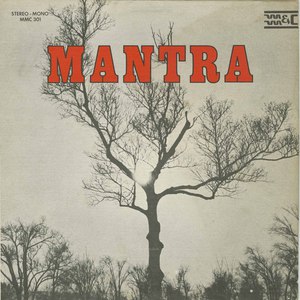Mantra
Websites:
No
Origin:
Montréal, Québec, 🇨🇦
Biography:
1970 was an extraordinarily fertile year for Canadian music. Across the country, bands and artists from every conceivable genre released LPs—many of them now prized rarities. Consider this lineup of albums released in 1970 alone:
Cargo, L'Experience 9, L'Infonie, Life, Greatrix Freedom Band, Christmas (two albums!), It's All Meat, Wayne McGhie & the Sounds of Joy, Bruce Haack, Hagood Hardy & the Montage, Tommy Graham and Friends, Innovation, Stephanie Taylor, Paul Lauzon, The Organization, Candy Rock Fountain, Sons of Erin, Noah, Spring Fever, Reign Ghost, Beverly Copeland, Souls of Inspyration, Trevor Dandy, Troyka, Gerry Hoelke and the Group, Morning Calm, Oliver Klaus, John Lyle, Judy Singh, Madrigal, Dianne Brooks, Tom & Judy, Happy Feeling, Fred Dixon & the Friday Afternoon, Sex, Brothers and One, Cycle, Nihilist Spasm Band, Ivar Avenue Reunion, May Blitz, Marius Cultier, 25ème Regiment, Freedom North, Perth County Conspiracy, Heads of Our Time, Marquis, Great Jones, Marc Hamilton, La Nouvelle Frontière, Phillip Werren, Kurt & Noah, New Creation, Flying Circus, Smyle, Magic Bubble, Claire Lepage & Compagnie, Blues Train, TCB, Mother Tucker’s Yellow Duck, Sullivan’s Gypsies, Jarvis Street Revue, Chimo!, Dionysos, Cat, and Fullerton Dam—all released albums in 1970. Even Allan Thicke put one out.
To gather all of these today, first you’d have to find them—no small feat. But then you’d also need a small fortune. As of 2025, assembling original Canadian copies of all these records in decent condition would cost well over $100,000 USD. Add another $300 if you want After the Gold Rush with the original Reprise red text label. Many of these albums are far too rare to track down and remain holy grails on collector wantlists worldwide.
It was also the inaugural year of the Juno Awards (then called the Gold Leaf Awards), launched by RPM Magazine in February 1970. That year’s winners included Andy Kim, Ginette Reno, The Guess Who, Tommy Hunter, Diane Leigh, The Mercey Brothers, Gordon Lightfoot, and the Poppy Family, whose “Which Way You Goin’ Billy?” swept both best single and album.
Amid all of this activity, Mantra quietly released their lone, self-titled LP on the tiny M.M. & C. label (catalog 301)—a French-Canadian imprint known almost entirely for fiddle and folklore releases. The Mantra album stands as the label’s sole psychedelic/folk record, and remains one of the most haunting and beautiful Canadian LPs of the era.
Formed by Darcy Draper and Dick Kelder in late 1969, Mantra was born out of a desire to break away from the high school cover band circuit (Black Sheep and Lost and Found) and explore original acoustic songwriting. Draper wrote and sang lead on most tracks, while Kelder contributed several quirky and melodic instrumental pieces. Together, they created something intimate, honest, and wholly unique.
The full band featured:
Darcy Draper: vocals, 6- and 12-string acoustic guitars, harmonica
Dick Kelder: acoustic guitar, vocals
Pierre Fauteux: bass, vocals (formerly of Lost and Found)
Graeme Lennox: piano, tambourine, autoharp (formerly of Size Five)
Dave Walls: percussion (also Size Five)
Larry Douglas: pedal steel guitar (of Mickey Lee & the Swingsters)
Roger Landreville: jaw harp
The album was recorded over just two days at Champagne Studios, 6900 St-Denis Street, Montreal, with Paul Ménard producing. The result is a spellbinding collection of reflective folk-psych: shimmering 12-string guitars, delicate harmonies, subtle instrumentation, and a deeply personal lyrical sensibility. There are no drums in the traditional rock sense—just carefully layered acoustic textures and emotional storytelling.
Standouts include Stay, San Francisco Morning, and the closer Dick’s Song. A lone 45 was issued on M.M. & C. as well:
"Stay" b/w "San Francisco Morning" (catalog #3604).
Though the group only played a handful of live shows—mainly in coffeehouses like The Yellow Door (Montreal) and Le Hibou (Ottawa)—their music caught the attention of CHOM-FM’s Doug Pringle, who championed the LP on-air and invited them for multiple live performances. But as Draper later recalled, “we all agreed we weren’t going to make enough to live on playing around Montreal, and since no one wanted to go to New York or L.A., we decided to quit.”
Still, the record’s local buzz helped pave the way for Draper’s next project: Back at the Beginning, released in 1972 under the name D’Arcy, featuring some of the same musicians plus guests from Mashmakhan. That LP, too, would go un-reissued—but both albums have gained increasing attention from collectors, DJs, and Canadian music historians.
Mantra is a one-of-a-kind release. Subtle, melancholic, and warm, it captures a fleeting moment of Canadian folk experimentation before the boom of singer-songwriters took full hold. It remains one of the great lost albums of 1970.
Surprisingly, it has never been reissued.
-Robert Williston, updated June 2025



